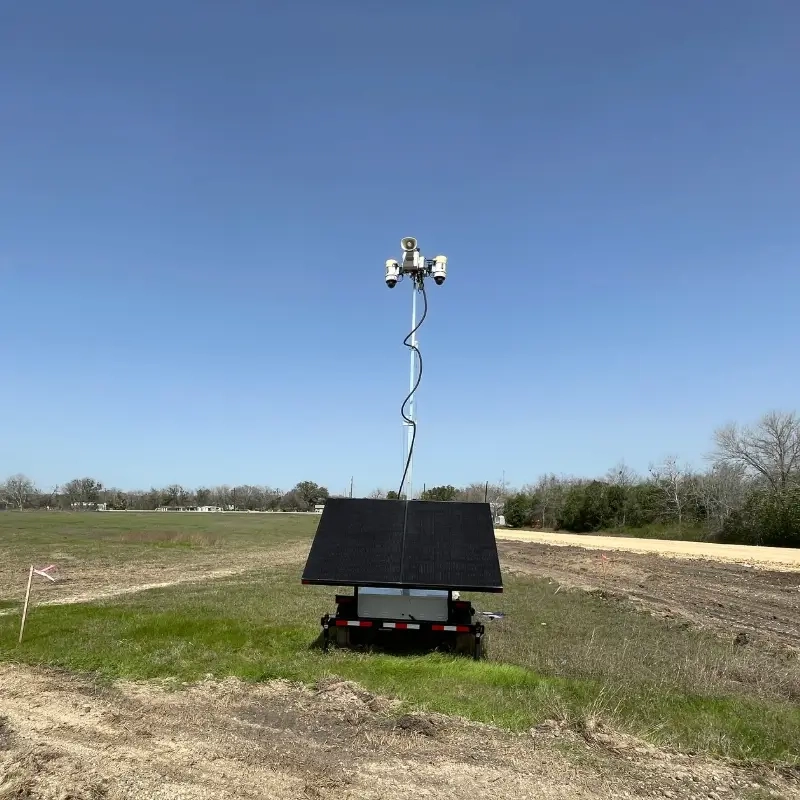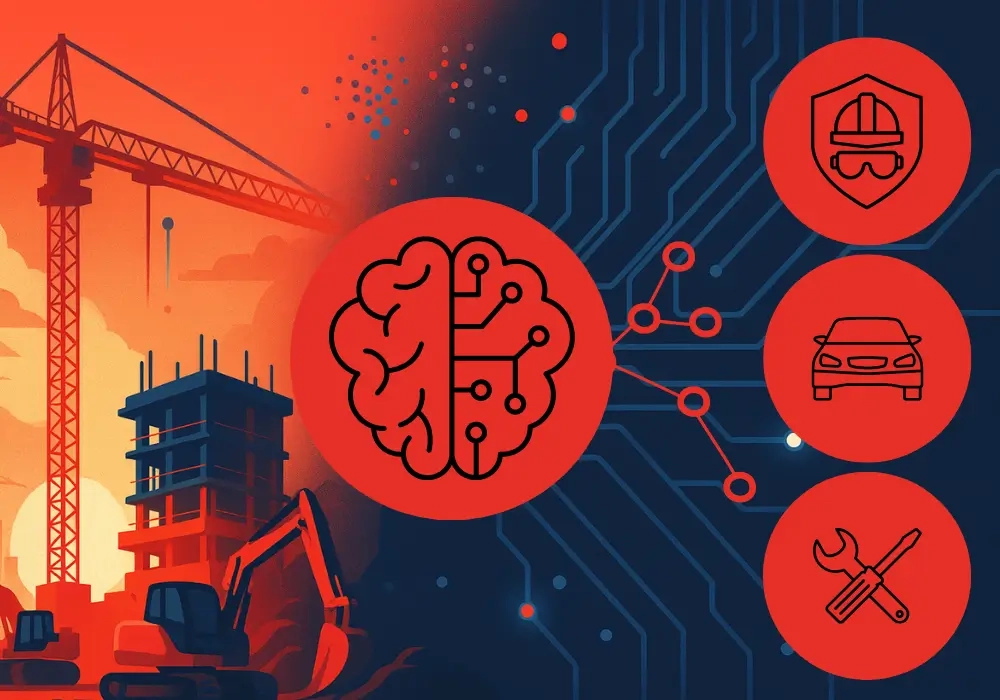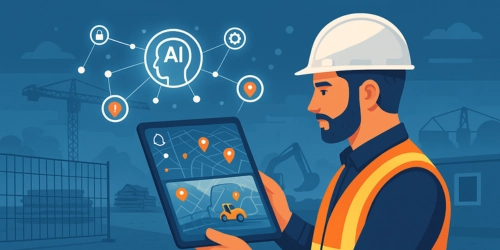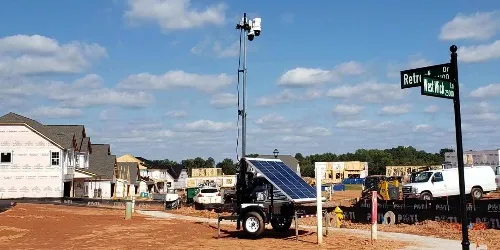Construction jobsites feel quiet before sunrise, but they're far from inactive.
While equipment rests and gates remain closed, connected security systems begin their routes. Cameras scan the site, sensors gather early data, and verification checks run in the background, setting the tone for a safer, more predictable workday.
In this article, we'll walk you through a typical day on a construction jobsite and see how integrated security systems keep everything running smoothly from morning to night.
4 Ways Connected Security Solutions Prepare the Jobsite Before Work Begins
Long before the first gate on the construction jobsite opens, integrated security systems are already preparing for the workday ahead.
Let's take a closer look at the 4 ways connected site security solutions do this:
1. Surveillance trailers establish perimeter coverage
Solar surveillance trailers are positioned around key access points. The mast-mounted cameras automatically monitor the jobsite with near-360° visibility. They deliver clear live and recorded video without any cabling or permanent setup, due to their PTZ (Pan-Tilt-Zoom) control, infrared (IR) night vision, and 4G/5G connectivity.
What makes this particularly valuable for construction security is that these surveillance trailers can be redeployed as often as needed. If the access road shifts or a new laydown yard is created, the trailer moves with it in minutes.
Read more:

2. Pole cameras offer 24/7 visibility
Mounted on buildings, poles, or temporary structures, pole cameras are ideal for monitoring fixed areas such as entry gates, material storage, and parking zones.
These cameras:
-
Offer consistent day-to-day visibility
-
Reinforce coverage where trailers can't be positioned, like narrow blind spots
-
Operate entirely through secure cellular networks
Together, trailers and pole cameras set the baseline for morning visibility.
3. Smart detection systems run self-checks
While cameras begin streaming, smart detection systems perform quick internal calibrations:
-
Motion-detection zones adjust automatically
-
Vehicle detection tools verify their boundaries
-
AI algorithms prepare to distinguish routine movement from activity that needs attention
This step is subtle, but important. Smart detection systems ensure the system won't flag motion caused by early-monitoring shadows, wildlife, or wind.
4. Environmental monitoring sensors set the day's baseline
Environmental monitoring solutions activate at the same time:
-
Air quality sensors track dust and emissions
-
Noise monitoring sensors capture sound levels
-
Weather monitoring sensors check wind speed, lightning, and temperature
If readings fall outside the jobsite thresholds, the security teams will receive an early morning alert before crews are exposed to changing conditions.
By the time workers arrive, the jobsite already has complete visibility of conditions, activity, and environmental status.
How Connected Systems Streamline Access Control and Compliance
The first hour of activity is often the most chaotic. Deliveries arrive, workers show up, and equipment begins moving. Integrated security systems help organize this busy period.
Access control supported by LPR technology
At the gate, licence plate recognition (LPR) cameras verify incoming vehicles against approved access lists. Instead of relying on radios or manual checks, the system matches plates automatically and flags unapproved vehicles for review.
PPE detection helps reinforce safe entry
PPE systems support safer starts by checking if workers are wearing the required gear when entering the site. If someone is missing a helmet or reflective vest, an instant live audio voice-down warning is triggered, together with a quick alert to a supervisor for follow-up.
It's a small step, but one that keeps compliance consistent from the beginning of the day.
Supervisors gain a real-time view of activity
As the jobsite becomes busier, construction security can:
-
View live video from surveillance trailers and pole cameras
-
Check access logs
-
Monitor high-traffic zones
-
Track vehicle flow
-
Verify equipment usage patterns
From a single dashboard, supervisors can identify where support is needed and spot potential slowdowns.
3 Ways AI-Powered Systems Improve Construction Jobsite Security
As the day progresses, activity becomes more complex, and this is where integrated security solutions make a real difference.
1. Intrusion detection reduces blind spots
Intrusion detection analytics scan for movement across restricted zones, material storage areas, and perimeter boundaries. The AI filters out:
-
Wildlife
-
Shadows
-
Blowing tarps
-
Passing vehicles
Only verified intruder movement triggers an alert, which means fewer false alarms and clearer attention where it's needed.
2. Smoke and fire detection enhances hot work safety
Smoke and fire detection systems use video analytics to identify early visual signs of smoke or flame. This includes open-air jobsites as well, which are places where traditional sensors often struggle.
This integrated system helps detect hazards linked to welding, grinding, or electrical equipment before they escalate.
Read more: Why Video Analytics is Best for Smoke and Fire Detection
3. Automated deterrents respond in seconds
When a verified event occurs, the response is immediate. The integrated system:
-
Activates strobes
-
Issues live voice-down warnings
-
Triggers sirens
-
Sends alerts to supervisors and monitoring teams
Because everything is connected, supervisors see the alert and the location instantly.
Why does this matter for busy managers? Security teams can't be everywhere at once. Integrated security systems give them a way to understand and respond to incidents without relying on guards or fragmented tools.
Read more: A Complete Guide on the Benefits of Mobile Surveillance vs. Guards

Monitoring Compliance, Conditions, and Performance with Connected Security Systems
As the day settles, focus naturally shifts toward compliance, environmental conditions, and end-of-day readiness.
Environmental monitoring tracks shifting conditions
Dust, noise, and wind levels change throughout the day. Environmental monitoring sensors analyze these conditions in real-time and notify security teams if readings exceed safe thresholds.
For example:
-
High winds can pause crane operations
-
Elevated dust levels may require suppression measures
-
Rising noise levels can trigger community-compliance alerts
Automatic logs support safer operations
Every alert (PPE, access, smoke, fire, intrusion, environmental) is logged with a timestamp and visual evidence. This reduces administrative work while creating accurate records for reviews.
Supervisors gain a predictable end-of-day view
By late afternoon, supervisors can easily review:
-
Access events
-
Compliance alerts
-
High-risk activity zones
-
Environmental thresholds
-
Equipment movement patterns
This approach saves time, reduces oversight blind spots, and supports proactive planning.
Read more: What are the Most Common Security Weak Spots on Jobsites?
24/7 Connected Site Security: How Jobsites Stay Protected After Hours
Once workers leave, the jobsite becomes more vulnerable. Integrated security technologies maintain complete visibility without requiring on-site guards.
Mobile surveillance delivers clear night time coverage
IR and thermal imaging from surveillance trailers and pole cameras ensure visibility even in low-light or no-light conditions. Solar-charged batteries keep the mobile surveillance units running without refueling.
Read more:
AI verification minimizes false callouts
The analytics continue working throughout the night, filtering unimportant movement and verifying real threats. If a trespasser, for instance, is detected near a restricted area, the integrated security solutions react instantly.
The Stellifii Advantage
By the end of the day, every piece of the integrated system on the jobsite has done its part. Each one protects, reports, and records in real-time. But what makes them truly powerful is how they work together.
That connection happens through Stellifii, our in-house cloud platform. Stellifii connects every WCCTV unit, from Solar Surveillance Trailers and Pole Cameras to add-on features like Smart Detection and Environmental Monitoring, into a single, secure interface.
A unified view of every system
From one dashboard, managers can:
-
Watch live or recorded video
-
Adjust threshold settings
-
Review intrusion, PPE, smoke, or fire alerts
-
Monitor air quality, noise, and weather
-
Export reports for audits or daily briefings
Scalable for multi-site operations
Stellifii is fully cloud-based, so there's no software to install and no IT setup. Every WCCTV unit connects through secure 4G/5G networks, making it simple to manage one jobsite or multiple locations at once.
Real-time insight for faster decisions
In practice, Stellifii is the thread that ties the entire connected jobsite together. It turns individual WCCTV systems into one coordinated network. This integrated system helps managers make decisions faster and keeps operations consistent from the first flights of the morning to after-hours protection.
Connect Your Site Security the Smart Way
Construction jobsites used to depend on walkarounds, radio calls, and hoping someone witnessed important events. But today, integrated security solutions work differently. They observe automatically and respond intelligently.
If you’re ready to move from reactive, physical security to connected, data-driven jobsite management, we can help you build it. Contact us to see how our integrated solutions, powered by Stellifii, can support your construction projects.
FAQs
How do connected security systems improve jobsite access control?
Integrated solutions bring access logs, video surveillance, and alerts into one place. This makes it easier for supervisors to verify who enters the jobsite and why. Instead of relying on standalone systems or separate alarm systems, everything is linked through a single dashboard.
What makes WCCTV’s security solutions different?
WCCTV combines all security systems into one cloud-based platform managed through Stellifii. Because the hardware and software are designed together, machine learning algorithms and artificial intelligence tools work consistently across every unit.
Can WCCTV’s surveillance system support multiple locations?
Stellifii is built as a scalable solution for single or multi-site operations. All WCCTV devices connect to the platform, allowing the security operations center to review incidents, check system health, and manage alerts from any location.
How does integrated monitoring improve operational efficiency?
Integrated monitoring brings physical security, access control, and video surveillance onto a unified platform, creating more efficient systems. Real-time alerts help teams spot security breaches sooner and improve overall security outcomes. With a clearer view of the security landscape, supervisors can respond faster and keep jobsites better protected.




